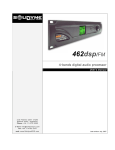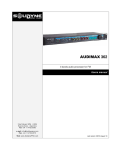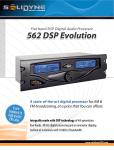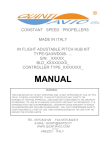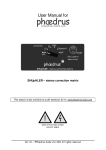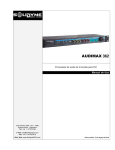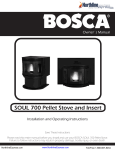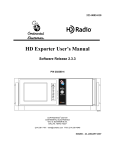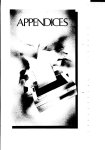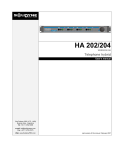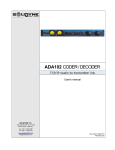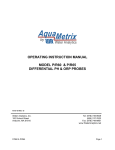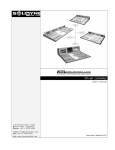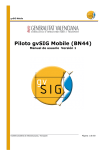Download Solidyne 562dsp AM
Transcript
562dsp/AM 5-bands AM digital audio processor Manual del Usuario 3 de Febrero 3254 (C.P. 1429) Buenos Aires - Argentina Phone: +54 11 4702 0090 e-mail: [email protected] Fax: +54 11 4702 2375 Web: www.SolidynePRO.com Last revision: June 2009 Table of contents Table of contents............................................................3 About this manual.......................................................................5 What’s in the box?.......................................................................5 About the montage.....................................................................5 ADVISES.......................................................................................5 Section 1 - Quick installation guide..............................6 1.1 Basic connection and settings.............................................6 1.2 Brief diagram for general connections.................................7 1.3 Understanding the main screen ...........................................8 Section 2 - Advanced installation...............................10 2.1 Generalities..........................................................................10 2.1.1 Power source...................................................................10 2.1.2 On Mounting....................................................................10 2.2 Analogical audio connections ...........................................10 2.3 Audio outputs......................................................................11 2.3.1 Main output for AM..........................................................11 2.3.2 WEBCASTING OUTPUT.................................................11 2.3.3 AES-3 OUTPUT FOR “DIGITAL AM”...............................11 2.3.3.1 Digital audio (AES-3)....................................................11 2.4 Console MICstart.................................................................12 2.5 Ethernet connection (OPTIONAL).......................................12 2.5.1 Set up..............................................................................12 2.5.2 Accessing from the LAN..................................................13 2.5.3 Accessing from Internet...................................................14 Section 3 - Starting up and operation........................16 3.1 Basic Actions.......................................................................16 3.1.1 Programas.......................................................................16 3.1.2 Modes of control..............................................................16 3.1.3 Using the jog wheel.........................................................16 3.1.4 Password.........................................................................16 3.2 INSTALLATION SETTINGS..................................................16 3.2.1 INPUT SETUP.................................................................17 3.2.1.1 INPUT SELECTION......................................................17 3.2.1.2 INPUT LEVEL...............................................................17 3.2.2 OUTPUT SETUP.............................................................18 3.2.2.1 OUT LEVEL.......................................................................18 3.2.2.2 AM POSITIVE MODULATION...........................................18 3.2.2.3 DIGITAL OUT....................................................................18 3.2.3 PROCESSOR SETUP.....................................................18 3.2.3.1 MIC PROCESSING PGM..................................................18 3.2.3.2 PASSWORD......................................................................19 3.2.3.3 PROCESSOR MODE........................................................19 3.2.4 Adjusting AM modulation.................................................19 Section 4 - Processing settings .................................20 4.1 PROGRAM SELECTION.......................................................20 4.2 PRESETS..............................................................................20 4.3 USER PROGRAMS...............................................................21 4.3.1 COPY PGM.....................................................................21 4.3.2 EDIT PGM.......................................................................21 SOLIDYNE 562dsp - AM broadcast processor 4.4 PROGRAM ADJUSTMENTS................................................21 4.4.1 PROGRAM NAME...........................................................21 4.4.2 EXPANDER / AGC..........................................................22 4.4.2.1 AGC OUT GAIN............................................................22 4.4.2.2 Atack time.....................................................................22 4.4.2.3 Recovery time...............................................................22 4.4.2.4 Hold..............................................................................22 4.4.2.5 Threshold......................................................................22 4.4.3 AUDIO EQ.......................................................................23 4.4.4 MULTIBAND COMPRESSOR ........................................23 4.4.5.1 Attack tiemes................................................................23 4.4.5.2 Recovery times ............................................................24 4.4.6 DENSITY EQ...................................................................24 Bass Clipper (Punch)................................................................24 4.4.5.2 Wide Band Limiter (WB)....................................................24 4.4.6 SRS WOW®....................................................................25 4.4.4.1 SRS TruBass®.............................................................25 4.4.4.2 SRS® (3D Enhancement).............................................26 Section 5 - Remote Control.........................................28 5.2 Installing...............................................................................28 5.3 Using the software...............................................................28 Section 6 - Audio processing for broadcasting........30 2.1 A brief history......................................................................30 6.2 Solidyne 562dsp psycho acoustic digital processor model 562dsp/AM.................................................................................32 6.2.1 Blocks diagram................................................................32 2.2.2 24 BITS @ 192 KHZ A/D CONVERTER..........................33 6.2.3 PEAKS SIMETRIZER......................................................33 6.2.4 SUBSONIC PHILTER......................................................33 6.2.5 LINEAR EXPANDER.......................................................33 6.2.6 GATED AGC...................................................................34 6.2.7SRS WOW........................................................................34 6.2.8COMPRESOR MULTIBANDA..........................................34 6.2.9 DENSITY EQUALIZER ...................................................35 6.2.10 I.M. CANCELLED CLIPPER..........................................35 2.2.11 LOW PASS 15 KHz DIGITAL FILTER ...........................36 6.2.12 AM BANDWIDTH PHILTER & NRSC-1.........................36 Section 7 - Measurements...........................................38 7.1MEASUREMENT PROTOCOL...............................................38 7.1.1 Checking the INPUT LEVELS..........................................38 7.1.2 Checking the OUTPUT LEVELS......................................38 Procedure:................................................................................38 7.1.3 FREQUENCY RESPONCE.............................................38 Procedure:................................................................................38 7.1.4 S/R..................................................................................38 7.1.5 STEREO CROSSTALK...................................................39 Procedure:................................................................................39 7.1.6 DISTORTION..................................................................39 Procedure:................................................................................39 Section 8 - Technical specifications ..........................40 Page 3 About this manual ADVISES Firmware Manual revision 3.07 29/05/09 Solidyne® All rights reserved. No part of this manual can be reproduced, be copied or be transmitted in any form or by no electronic or mechanical procedure: or in its totality or partly. What’s in the box? You must find the following components into the box. a) 1 Solidyne 562dsp processor b) 1 user’s manual c) 1 AC Interlock d) 1 CD-ROM with VirtualRack 5 software. e) 1 Guaranty certificate f) 4 self-adhesive rubbers tops Please check when receive to verify that all components are okay. AC Voltage The unit cans wok with 110 or 220 VAC. A voltage switch on the rear panel selects the correspondent voltage. ALWAYS CHECK THIS SELECTOR BEFORE PLUG IN. In order to reduce the risk of electrical shock, do not retire the covers of the cabinet. The internal pieces do not require maintenance of the user. Refer the technical maintenance to qualified personnel. The power cord provided with the unit gives Earth return to the processor. Do not replace it nor uses adapters. MAKE SURE THAT HAVE WITH A GOOD GROUND TAKING. The exclamation icon within a triangle that appears in this manual is for alerting to the user about the presence of important instructions on the operation and maintenance of the equipment. About the montage 562dsp processors are designed for rack montage in standard racks of 19”, requiring 3 rack height units. If you prefers, the processor can be placed on a table. Four self-adhesive rubber tops are given for this purpose. Letter “i” within a circle that appears in this manual is for alerting to the user about the information; advices and tips of extreme importance. When mounting, start fitting the bottom screws, and soon the superior ones. Use flat screws with flexible o-rings (rubber, PVC, etc.). The frontal panel is made of aluminum, so you must take special care of don’t to apply excessive force on the screws since it can cause deformation or even break the angles of the panel. Page 4 AM broadcast processor - SOLIDYNE 562dsp Section 1 Quick installation guide 1.1 Basic connection and settings CONNECTIONS Power supply SETTINGS Controls Before plug in; check the position of the AC VOLTAGE selector, on the rear panel (200240 V, 50/60Hz; or 100-130 V, accords to correspond). Inputs All settings values are entered using a JOG Wheel. Turn the JOG to select options and to change values. Pressing briefly the JOG, confirms an option. Pressing and holding the JOG (around one second), go to the main menu. Each screen graphically indicates the actions available with the JOG (see figure). Input The analog audio inputs are Balanced XLR (female). Connect the PGM output of the console to these inputs, caring not to invert the phase. ALWAYS connect BOTH INPUTS. If the output of the console is mono use cable type "Y". The unit has (optional) AES-3 i/o for digital AM transmission. Supports 16/24 bit and frequencies from 30 KHz to 96 KHz. The connector is a female XLR. When using this input, we also connect the analog inputs. The 562dsp/AM has an automatic switching in case of failure in the digital input. The default input level is +4dBu. If your console manages a different level, you must adjust the processor input level. Press briefly the JOG to enter to the main menu. Choose the option “Setup Input” and adjust the level according to the nominal specified on your console. Programs Your radio already is on the air with the sound of the Solidyne 562dsp. At this point, you must be anxious to listen what 562dsp is able to do with the sound of your radio on the air… to begin we will explain briefly how to select the factory presets. Tunes your radio in a good audio equipment and do the following: Outputs There are 2 audio outputs for AM transmission. Both presents the same signal (L + R). Connects one of the 562's outputs to your transmitter. The output level adjusts from Settings menu (Output setup). Maximum output level is +12 dBm (balanced). Power on The unit has an ON/OFF switch on the rear panel. The main screen Hill show a welcome splash on start up; and then will load the last used program. SOLIDYNE 562dsp - AM broadcast processor Turn the JOG. Note on the screen how the different presets programs names changes. Pressing briefly the wheel load the program, changing the processing and the sound on the air. The 15 PRESET PROGRAMS can not be changed. You have 15 USER MEMORIES to create your own adjustments. You can start copying a preset program to a user memory, and soon modifying it. Page 5 1.2 Brief diagram for general connections 1. 562dsp/AM has the audio output duplicated for AM transmission. Second output can be used to conect a back up transmitter. 2. In previous example, the link from Studio to Transmission Plant was made using an RF link, and transport the processed audio from 562dsp/AM to the transmitter, located far from the Studio. In others configurations, processor locates at the transmission plant, and STL transport the PGM signal. (you can use a second link for backup). In this case, remote control of 562dsp/AM can be made if the link has an available a data channel Page 6 for send RS-232 data; or using an 562dsp/AM-IP which allows remote access via Ethernet network. 3. The audio output for webcasting is stereo, with extended range (20 Hz – 15 KHz). Is a good solution for retransmit the emission through Internet. 4. Although the processor connects to the console via AES-3 (or a digital link), we recommend to connect the analog audio (or analog link for back up). In case of absence of digital signal, 562dsp/AM automatically switch to the analog inputs. AM broadcast processor - SOLIDYNE 562dsp 1.3 Understanding the main screen Next you will see an overview on the 562dsp/AM main screens. Later each processing stages and its settings screens are fully analyzed. When the unit starts up; the boot screen appears on both screens showing the current version of the firmware. Once started, the unit presents the main screen at the left, and the main menu at the right. Next, the main screen is described briefly as introduction to the 562dsp/AM graphical environment. The progressive bars show the action of several processor stages. The name of the current preset and state of inputs and outputs also appears on this screen. From left to right you find: The input VU meters (L & R). Below the vumeters an overload (OVL) warning can appear, if the input level reach 8 dB before the “digital clipping” level (@ +18dBm). This warning turns off last 5 seconds when the “clipping” condition disappears. AGC bar shows the action of the Automatic Gain Control, which fits the input gain so that the signal arrives at the processing stages with constant level. If the signal from the console arrives with low level (or too high), the processor automatically compensate its input gain so that the output level is unvarying. If the input signal falls abruptly, the AGC holds its current value; to avoid an undesirable effect known as “breathing”, that appears when the signal is very low and the AGC compensates their gain excessively increasing the background noise in the voice intervals. This feature knows as Gated-AGC. In normal operation this indicator will have to work at middle scale (15 dB) The following indicators show the action of the multiband compressor. There are five compression bands called loudness bands (LF, M1, M2, HF, SH). These indicators (like the AGC) show the gain reduction applied to the signal, for that reason they “grow downwards”. Band LF corresponds to bass notes of the audio, below 160 Hertz, M1 and M2 to mid tones and HF and SH to the highs. SOLIDYNE 562dsp - AM broadcast processor The LOUDNESS concept associates to the sensation of sonorous power perceived by the human ear. With no need to exceed the maximum percentage of modulation fixed by the law, the processor can obtain that the radio sounds stronger. The radio with better processing will be the one that better sounds in the dial. As will be explained later, another objective of the processing is to increase the energy in the entire audio spectrum, to produce the maximum possible modulation in the RF carrier, which is translated in greater radiated energy, improving the transmission reach in marginal areas. For this, the processor applies a complex procedure of compression on each audio band, producing greater sensation of loudness to the ear. The size of each luminous bar indicates the compression degree at every moment. Its effects, obviously, changes according to the different types of music and voice; but in general can say that when a band indicator begins to light (values up to 10 dB) the action is smooth and is totally accepted by the human ear. With values of 15 dB or greater will notice a greater “sonorous force”, being a level of extreme processing. Another important value to consider is the recovery time. This is the time that takes a band in recovering its previous gain. This is evident at first viewing the indicators. The slower it’s the recovery, the processing sound soft and the music sounds natural. However, when they are fast, an increase of the loudness takes place, but the sound can becomes more “rough”. “AES In” indicates if the unit is using the digital input. It activates just at the moment at which the digital data enter. = digital input = analog input Finally; the screen shows the name and number of the current program. You can explore the programs list turning the JOG; but a program is not active until you load it pressing briefly the wheel. A program is a set of values stored in an internal memory. You access to the MAIN MENU (the right screen) by pressing and hold the JOG wheel. From here you can access to all functions and features of the processor. Page 7 THIS PAGE INTENTIONALLY LEFT BLANK Page 8 AM broadcast processor - SOLIDYNE 562dsp Section 2 2.1 Generalities 2.1.1 Power source • The AC voltage variation must stay smaller to 10%. Otherwise, uses an UPS. Always CHECK the correct position of the VOLTAGE SELECTOR (200/240 V o 100/130 V, according to the country) • Do not mix AC wires with audio wires, especially with analogical ones. Remember that all audio installation must have a good grounding. We recommend accomplishing with the effective norms Article 810 of the National Electricity Code (NEC); ANSI/NFPA Nº 70-1984 in USA; IRAM 2379 and 2281-3 in Argentine. This norm provides information and guidelines for a consistent grounding. 2.1.2 On Mounting • 562dsp can be mounted in a standard rack of 19”; or can be used on a table. Rubber tops are provided with the unit. Do not place the unit on unstable surface or shelf; the apparatus could fall, causing damages to someone and to be damaged the unit. • The ambient temperature must stay between 5ºC and 40ºC. Avoid direct solar ray incidence on the processor or proximity of heat sources. • The openings and grooves allow the circulation of forced air impelled by the internal cooler. Not obstruct the refrigeration of the internal components. Openings do not have to be blocked nor covered. Advanced installation (AM or FM). Avoid strong electromagnetic fields (power transformers, big motors, etc). 2.2 Analogical audio connections Inputs and outputs are electronically balanced. The inputs are “bridging” type, with impedance greater than 10 KOhms. The connectors used, as is standard, are female XLR-3 for the inputs and male for the outputs. Take special care with the phase. When pin 2 is positive (+), modulation on AM carrier must be positive. This is very important to allows the increasing of power using asymmetric modulation (increasing the positive modulation peaks). Always connect both inputs. If the on-air console has one mono output, connect in bridge (parallel) the left and right inputs at 562dsp. If you connect only one input (left or right) the input signal will be 6 dB lower. Take care with the PHASE in all connections. Connect always BOTH inputs of stereo pair. Use one pair shielded audio cables of GOOD QUALITY, preferably with double shielding. The maximum length recommended is 30 meters, although in special cases it is possible to achieve 100 meters accepting a little loss at high frequencies (anyway that is not significant in the transmission of conventional AM). The connection of this cables are made as is standard. See the following table: • 562dsp has internal protection against RF fields, which allows locate it next to transmitters SOLIDYNE 562dsp - AM broadcast processor Page 9 Balanced input and outputs 1 = GND • Take specially care of maintain the positive phase. Output XLR Pin 2 XLR is the positive phase and must coincide with positive modulation of transmitter. This is important for the working of the increasing power system based on the grow of positive modulation peaks. 2 = balanced positive (+) 3 = balanced negative (-) Unbalanced connection Inputs: Signal = 2; 1 and 3 to GND Outputs: Signal pin 2; leave pin-3 unconnected. GND = pin 1 2.3 Audio outputs The 562dsp/AM has 3 audio outputs: Main output for AM transmission; extended range for web-casting or digital AM; AES-3 for digital AM (opctional). 2.3.1 ON CONNECTIONS Main output for AM Is a double balanced output (XLR) for AM analog transmission. Both connectors sends the L + R signal. The double output allows working with two transmitters at the same time, one for main transmission and another one for back up or night transmission. The bandwidth can be switched, by internal jumper, between 5 KHz and 7.5 KHz (see next). Main outputs supports asymmetric positive modulation and the level can change from +4 to +12 dBm (See “3.2.2 – Output settings”). 2.3.1.1 A.M. AUDIO BANDWIDTH The high frequency cut for main audio outputs can be 5 KHz or 7.5 KHz (default), changed from an internal jumper. To modify the cut frequency, remove the top cover from cabinet and look for the TX AM PCB. There are only one jumper in this board, showed in the figure. By default, 562dsp/AM cut frequency is 7,5 KHz. • Both input channels of the 562dsp/AM must be connected. In case of the on-air console has only one mono output; connect the inputs channels (L and R) in parallel. • If you hear some residual humming when the system is started up, power off the processor. If humming disappear, check the input connections of processor. If, however, the humming remains (and only remove unplugging the audio output cable) this would indicates the processor is not properly connected to ground. 2.3.2 WEBCASTING OUTPUT This is a stereo balanced output (XLR) with extended range (20Hz / 15KHz). Usually it is used to Internet streaming. The output level is fixed @ –2 dBm. The soft clipping applied to AM audio also improves the performance of streaming coder. All AM/FM processors has ‘clippers’ to limit PERFECTLY the peaks of the signal to 100% of modulation, to avoid over-modulation and reach greatest loudness. In psychoacoustic digital coding (i.e.: MP3 compression) the audio processor must to increase the bands loudness but without digital clipping; since clipping sounds bad when is codified at low bit rates. This is because the clipping generates a distortion with an spectrum similar to white noise, difficult to be codified with low bit rates. In addition, it adds distortion to the own distortion of very low bit rate MP3, making the total distortion audible (it is not masked). Esta salida también encuentra uso como salida de grabación de alta calidad, permitiendo registrar con calidad FM el audio procesado de la transmisión AM. 2.3.3 AES-3 OUTPUT FOR “DIGITAL AM” Models 562dsp/AM/AES are for digital transmission using simulcast with IBOC o DRM technologies. Has AES-3 inputs and outputs to connect the digital transmitter, with a bandwidth of 15 Khz. 2.3.3.1 Digital audio (AES-3) Digital input allows connect sources with following settings: Resolution: Sample rate: Page 10 16 - 24 bits 30 KHz - 96 KHz. AM broadcast processor - SOLIDYNE 562dsp Internally 562dsp/AM works at 24 bits/192 KHz. The digital input signal is converted by the “Resampler” stage. While using the digital input, also connect the analog inputs. In case of lost connection digital, the processor automatically switches to analog inputs. The entry selected from the menu "Input", as explained later. S/PDIF: you can connect an S/PDIF output to the AES3 input of 562dsp using an S/PDIF to AES-3 adapter. The figure shows a compact adapter XLR BNC. AES-3 output has a resolution of 24 bits with a sample rate selectable between 48 - 96 KHz (see “3.2.2 – Output Setup”). The connector is male XLR. AES3 input and output cables connect as following: XLR Signal 1 GND 2 AES3 (1) 3 AES 3 (2) The relay coil voltage depends on the voltage gives by the console. When the relay receives voltage, the contact is closed activating the Mic Start function in the processor. The voice’s program remains active while the contact is closed. This feature comes disabled from factory. In order to use it, you must enable the option “MIC PROCESSING” in the processor setup (see “3.2.3 - Processor Setup”). 2.5 Ethernet connection (OPTIONAL) 562dsp-AM/IP allows to control the unit via TCP/IP protocol. Before the detailed explanation, a brief description on the settings needed to use 562dsp-AM via IP: 1 Connect the processor to the LAN (Hub, Switch or Router). 2 Check the IP address of the unit using “DS Manager” software (this tool is available into the folder “IP-Access” in the original CD). 2.4 Console MICstart 3 562dsp can changes the current processing program when the study microphones activates. In this way you can use a processing specially done for voices. The default adjustment for voices is the program “09: Voice Impact“. Obviously; you can copy and customize this preset. A PC will be used to run the software and to access to the 562dsp-AM hardware. We call to this PC “remote computer”. Install in the “remote computer” the “VirtualRack” software, provided with the unit. 4 Install in the “remote computer” the Virtual Serial Port”. If there is a Firewall (by software or hardware) you must enable port 1101 for the communication with the 562dsp-AM. 5 Run the Virtual Rack software, it will explore the first 5 ports to detect the audio processor, if not detected you must set the port number in the file serial.ini 6 To access from outside to the LAN, please refers to “2.9.3 –Accessing from Internet” standard connection for AES-3 The commutation takes place when grounding the MICstart input. When this happens the processor exchanges the program and the access from the JOG wheel is blocked. When the MICStart input is opened, 562dsp returns to the previous program. “Console MICstart” uses an RCA connector. With consoles Solidyne 2300 series, MICstart is connected directly to the Digisolid output of a microphone channel (please refers to the manual of the console). In other consoles, the control can be solved using the tally signal to activate a relay. Connect the relay contact directly to the RCA “MIC Start”; and the coil in parallel to the tally light. SOLIDYNE 562dsp - AM broadcast processor 2.5.1 Set up Connect the 562dsp-AM/IP to the LAN and turn on. Next to the connector RJ45 a green LED will light. If amber LED lights then the network detected is of 100Mbps. Install and run “DS Manager” tool, which provides in 562dsp-AM/IP CD-ROM (folder IPACCESS). This tool will show all active units connected to your LAN. Each unit has a MAC address (Ethernet card address) that is unique and comes fixed from factory; and an IP address that you can change freely. Page 11 You can make a PING to verify the access to 562dsp-AM/IP hardware from the terminal. Another option is to use the button [BUZZ] from the main window of the DS Manager and you will see the LEDS of connector RJ45 to blink during one second. If you wish, you can set a password to block modifications in your settings. 2.5.2 Accessing from the LAN The client PC must have installed TCP/IP protocol. If there is a Firewall (software or hardware) it must enable port 1101 for the communication with the 562dsp-AM/IP. Select the unit from the list and press the button [Settings]. Here you can define a new IP. In this example the local area network uses address like 192.168.0.x, to accede from any terminal of that network to 562dsp-AM/IP you need that IP address is compatible. Assign a fixed IP that it does not generate conflicts with another terminal (in the example 192.168.0.11). If you have a DHCP server you can obtain a dynamic IP address, although if IP changes frequently will require changes in the configuration of the clients (or in the LAN like for the access from Internet). Install the driver `Virtual serial port' that allows to communicate with the processor. The tool is ‘Connection Wizard', with this you must create a new serial-port <-> IP address connection. Assign the Gateway address (usually 192.168.0.1), and the subnet mask. This is needed if you wish to accede to the 562dspAM/IP from outside of the LAN. If you don’t know these values, contacts to your network administrator. The port used is 1101. You can change it in case of conflicts with another application who uses the same port, but this rarely occurs. In the ‘Serial Port’ section, ensures that the DTR mode is set to: 1- Indicate connection status. Page 12 AM broadcast processor - SOLIDYNE 562dsp incoming by port 1101 to local IP address assigned to 562dsp/IP (in our example 192.168.0.11), and redirect also the port 65535. The following is an illustrative example; the screen of present configuration depends on your router. Virtual serial port must install in each PC from which it is desired to accede to the 562dspAM/IP. Once installed the virtual serial port it must appear in the Windows Devices Manager. Some routers offer the option `Virtual Server', that is similar but more outpost than the ‘Port Forwarding'. Soon you will have to install in your PC (with ‘Connection Wizard') the virtual serial port. The IP address here entered is the external address of the local area network. VirtualRack software automatically explores the first 5 ports to detect de 562dsp/IP hardware. 2.5.3 Accessing from Internet If you want access to a 562dsp/IP located outside your LAN; there are two possible ways in which the device can be connected to the network. The unit is connected directly to Internet: In this case you must enter the IP address assigned by the Internet provider (ISP). In order to know the external IP you must see the settings information of your router. Now you can run Virtual-Rack end user software so that that it communicates with your 562dsp/IP via Internet. The unit is connected in another LAN (with shared Internet access): In order to accede from an remote PC to the LAN you must configure the router of that LAN to redirect the packages SOLIDYNE 562dsp - AM broadcast processor Page 13 THIS PAGE INTENTIONALLY LEFT BLANK Page 14 AM broadcast processor - SOLIDYNE 562dsp Section 3 Starting up and operation 3.1 Basic Actions 3.1.3 3.1.1 All the installation settings and each parameter of audio processing are managed with the JOG wheel into a friendly graphic interface. Programas 562dsp has 15 presets programs and 15 user memories. Programs from 00 to 14 are programs made by the engineers of Solidyne, ready to be on the air. There are different adjustments for different sound styles and sonorities. Processing programs are described with detail later. You can customize the programs copying it to the user banks (15 to 29) and edit them. User memories are “empty” by default (“flat” processing). You can create a new adjustment changing the values of each parameter on the user memory; or copying a preset to the user memory (recommended). See “4.3.1 – Copy programs”. 3.1.2 Using the jog wheel The frontal panel presents a big blue screen of dot matrix, and a rotating control (JOG) with push button. Their use is very simple: • Turn the JOG control to select an option or to change values (i.e.: changing levels; select Yes/No; etc.) • To confirm an option/value press the JOG briefly. It’s like make “click” with the mouse. • Push and hold the JOG by a second to enter to the Main Menu or to cancel a screen. It’s the equivalent to double-click with a mouse. Modes of control The processor can be controlled of many ways: a) Can be manually controlled from the frontal panel. b) Connecting the unit to a PC, you can create and edit programs using the 562dsp VirtualRack software. This software allows to save the 562’s programs in the Hard Disk (files .562) that you can send by mail, so that other radios that you manages share the customized adjustments. In addition; this software allows creating a scheduling programming, to change the processing program at certain hours from the day. Virtual Rack runs in background using very few resources. In fact this software can run on the OnAir computer. 3.1.4 Password You can define a password of 3 characters (letters, numbers and signs) to avoid that non authorized people make changes on the programming adjustments. Each time that you try to access to the main menu the processor will ask you for the password. Note that you don’t need the password to change the current preset on-air. Please see “3.2.3 - Processor Setup”. 3.2 INSTALLATION SETTINGS c) Models 562dsp-AM/IP allows direct connection to the LAN. You can run the software VirtualRack from another terminal to control the 562dsp/IP. a) On start up, the 562dsp-AM shows by a few seconds the boot screen indicating the firmware version: With the appropriate network configuration, you can adjust the sound of the radio in real time... from your Laptop, while drinking a cup of coffee at the living room of your home; listening you favorite audio system, which sound you know very well. Once started; the processor present the main screen; described in the item 3 of the Chapter 1. By the other hand, this feature allows to adjust the processing from far distances, to optimize the reception in areas with marginal coverage. Please see “2.5 – Ethernet connection” SOLIDYNE 562dsp – broadcast audio processor The unit always starts loading the last used program. Página 15 b) Pressing and holding the JOG you accede to the Main Menu of the right screen. Note that a little arrow appears below “EDIT PGM”. Once into main menu; turn the JOG until select the desired option. The selected option is marked by a little arrow that appears below the icons. Touch briefly the JOG to confirm the selection. WARNING Remember that being in the main screen, turning the JOG or touching it briefly, you accede to the mode ‘program selection’. In this mode; turning the JOG you explore the 562’s programs. In order to leave the ‘programs selection’ mode, press and hold the JOG. In order to accede to the main menu press and hold again. If being in the main menu or any settings screen changes not occur during 10 minutes, the unit returns to the main screen, discarding the changes. 3.2.1 INPUT SETUP Here you define the audio level and type of input. The operation on this screen follows the concept of the previous ones: to select an option (“Input selection” or “Input level”) turn the JOG and touch briefly to confirm. Now turn the JOG again to change the value of the chosen option. Touch briefly to confirm. finding only silence or a total lost of digital AES/3, the unit switches to the analogical inputs. This type of faults in signal AES/3 is characteristic when “a digital data link falls”. As signal AES/3 is regenerated in the receiver, the digital streaming follows present, but without content of audio (channels muted). Reestablishing the signal in Auto Search mode: After losing AES/3, or in absence AES signal, or absence of audio in this digital signal, the equipment switches automatically to the analogical mode. The reestablishment to the digital mode happens in immediately in case signal AES/3 is had completely lost. Since when recognizing a valued digital carrier, the processor quickly returns to use the digital audio like source of incoming signal. In case the digital signal exists, but the same one contains silence, the processor operates as follows: At intervals of 5 minutes the processor interrupts briefly (1 sec) the audio on the left channel, connecting in its place the digital signal of the left channel; verifying soon if the digital signal were reestablished. If it continues in absolute silence, then it reestablishes the analogical signal. This process is repeated time and time again until as returns signal AES/3. When the digital audio reappears, the processor returns to digital mode. While the digital signal remains absent, the audio on the left channel is briefly muted at intervals of 5 minutes, to alarm to the engineers of the radio (and to the operators) that the processor is working with the analogical backup inputs. This has been intentionally designing in this way, since otherwise; an accurate confirmation does not exist on problems in the signal AES/3. 3.2.1.2 INPUT LEVEL Define the nominal level of the input signal. So that the AGC (automatic gain control) operates correctly, is very important to fit this level correctly. 3.2.1.1 INPUT SELECTION Analog: Select this option when the processor is connected ONLY through the analogical input. Digital only: Choose this option when the unit is connected ONLY through AES/3. Also the analogical inputs can be connected, as back up, but they will be used only in case that the carrier of signal AES/3 interrupts. In this case, 562's automatically switch to analogical inputs, being in that mode until the digital signal is reestablished. Auto Search: (default) It uses the AES/3 digital inputs in case of finding a source of digital signal. Otherwise, uses the analogical inputs. In case of Page 16 This value must agree with the nominal output level of your console (in the case of Solidyne consoles this level is + 4 dBm). NOTE: If you unknown the output level of your console, put the console’s level at 0 VU peak and reads the level in the 562dsp’s input VU-meters. With the adequate input level, the AGC will work with around 10 to 15 dB of gain reduction. This can be seen in AGC indicator who will have to indicate 15 dB with strong program signal, lowering to 8 dB or less when the signal reduces. If the program signal level abruptly falls, the indication “HOLD” appears. SOLIDYNE 562dsp - broadcast audio processor Overload warning (OVL): appears in the main screen when the input signal reaches +10 dBm; that is to say, +8 dB before the ‘digital clipping' threshold (placed at +18 dBm). The indication disappears last 5 sec if the clipping disappears. The digital input fulfills recommendation AES-K12, applied to broadcasting, which takes as reference for 0 VU a digital input level of - 12 dBFS. This implies 12 dB of headroom. Defines the sample rate (fs) for AES-3 output (only models 562dsp-AM/AES). Supported sample rate are 96 KHz / 48 KHz. 3.2.3 PROCESSOR SETUP Input level can not be changed when digital input is used. 3.2.2 OUTPUT SETUP 3.2.3.1 MIC PROCESSING PGM MICstart input allows to change the processing program when the operator activates the microphones at the console, applying a specific processing to obtain high impact voices. 3.2.2.1 OUT LEVEL It refers to the analog audio output for AM transmission. The level changes from +4 dBm to +12 dBm (balanced). Take in mind that if you connects this output unbalanced (not recomended) level falls 6 dB. Both analog audio outputs are monophonic, so both presents the sum L+R. Bandwidth is limited for AM transmission, by a 5 th order philter with cut frequency conmutable between 5 KHz and 7,5 KHz (default). To change this please refers to “2.3.1.1 AM Audio Bandwidth” 3.2.2.2 AM POSITIVE MODULATION The audio output for AM transmission allows asymetric modulation to increase the power ans reach of the emission. While negative modulation stays at 100%, positive modulation can change from 100% to 150%. An advanced “asymetric clipper” with double stage of log clipping, developed by Solidyne, allows to increase the transmited power and the covered area. This system easily meets the standard NRSC-2 irradiation of spurious AM. 3.2.2.3 DIGITAL OUT The level of the extended range audio output is fixed at -2 dBm Please see “Adjusting AM modulation” at the end of this chapter to know how to adjust the output level. SOLIDYNE 562dsp – broadcast audio processor This is a very useful feature, since it’s not possible to obtain an adjustment that sounds optimal for music and voice simultaneously; for being two audio signals morphologically different. The attack and recovery times of the AGC differ sensibly for both cases; and must be carefully fit to avoid that its action is audible. This option is disabled from factory (program 30:Mic processing off). In order to enable it, select “Mic processing PGM” and choose a program created for voices (for example 09:VOICE IMPACT). The commutation controls from a connector in the rear panel, detailed in the installation chapter (see “2,5 Console MIC Start”). When you open the microphone faders in the console, 562dsp/AM make a smooth transition, changing the values of the adjustments gradually. This is because a sudden change could cause a "click" on the air. Before proceeding, please consider the following recommendations: TIPS The programs for “music” and “voice” do not have to be radically different. The gains of the density EQ and the AGC output must stay without greater variations. The differences will be fundamentally in the attack and recovery times of the AGC and the multiband compressor. It agrees to create the adjustment for voices starting from the adjustment chosen for music. The attack and recovery times used for music usually are slower than those required for the voices, mainly in the AGC. Observe and compare the factory presets. Página 17 3.2.3.2 PASSWORD You can define a password to avoid the access of unauthorized personnel to the main menu to change the settings. Once defined, 562dsp will ask for the password whenever you try to accede to the main menu, but you don’t need the password to explore the program list and change the program on-air. The password must have 3 characters. Any combination of letters, numbers and symbols can be used. a) To enter a password, go to field “Password” turning the JOG and touch it briefly to confirm. b) A flashing cursor appears to enter the first 3.2.4 Adjusting AM modulation Must be done with an oscilloscope, increasing the processor's output level (Main Menu → Output Settings). TX AM output maximum level is +12 dBm in balanced mode. Negative peaks must reach exactly to 100 %, whereas positive peaks can be adjusted between 110 to 130% using the control asymmetric modulation. Exceptionally, some modern transmitters supports up to 150% of positive peaks, but this extreme setting generally affects the audio quality. character. Turn the JOG until reach the wanted symbol and confirm with brief touch. The cursor will jump to the next character. c) Proceed in the same way to choose the others characters. d) After confirm the last character, the option “OK” is on focus. PRESS AND HOLD to confirm the password. A brief touch in this point will make jump the cursor to the first character again. e) Press and hold the JOG cancels the process in any instance. (equivalent to escape), except when “OK” is selected, in such case confirm the password! f) To delete the password, edit it entering 3 space characters. Write down the password in a secure place, in order to do not loose it. If you forgot the password, please contact with you Solidyne dealer. 3.2.3.3 PROCESSOR MODE Shows the processor type. The unit can be prepared for FM or AM stations. This is defined in factory, because requires some internal changes in the circuit board; as well as a different programming of the flash memory with the corresponding constants for the AM band. Page 18 SOLIDYNE 562dsp - broadcast audio processor Section 4 Processing settings 4.1 PROGRAM SELECTION The unit has 15 default programs (00 to 14) and 15 user memories. The programs selects from the main screen. Turn the JOG to explore the list and touch briefly to put a preset on the air. • Note that, while you explore the programs, over the program name appears the navigation instructions. • While these instructions are on screen, you are in the mode “exploring programs”. • Selecting a program this legend disappears. • Touch and hold the JOG to cancel the exploration. The name of the current on-air program returns on screen. CHANGES WILL TAKE EFFECT WHEN YOU CONFIRM A PRESET PUSHING THE JOG. 4.2 PRESETS 562dsp/AM has 15 programs created by the Solidyne engineers. Next each preset is explained. These adjustments are the base for the creation of new programs. Please refer to “4.3 – User programs” for details about each processing stage. 00: VOICE 1 01: VOICE 2 08: AM SOFT 2 09: AM SOFT 3 02: AM HARD 1 03: AM HARD 2 10: AM SOFT 4 11: BASS BOOST 1 04: AM HARD 3 05: AM HARD 4 12: BASS BOOST 2 13: BASS SOFT 1 06: AM MUSICAL 07: AM SOFT 1 14: BASS SOFT 2 Adjustments were made based on a schedule dominated by voice and dialogues. The main difference of this adjustment in regard to the settings for music are the attack and recovery times, both the AGC and multiband compressor. The AGC must recover fast to compensate, for example, a telephone communication that arrives with low level. The hold threshold must be relatively low, around 17 dB, to avoid that the AGC “is hooked” and, in this way, to obtain that it reacts quickly before any SOLIDYNE 562dsp – broadcast audio processor difference of level between different voices. Remember that the objective is that the voices always sound on the air with the same level. The attack of the AGC also must be fast, to make level abrupt changes of level that can take place by shouts (discussions) or outbursts of laughter. The speed of attack of the compressors must be fast, specially in band M1, to contain great impulses that take place in the beginnings of phrases, when the compressors begin to work. If the attack times are long, can take place excessive processing and clipping of the signal in certain entrances of the speaker; that is to say, the speaker will sound “saturated” or “dirty” during a brief moment when he begins to speak (and before each silence bigger than recovery time). On the recovery times there is more freedom, reason why they will be fit according to the type of voices of the radio. Like general rule, remembers that long recovery times produce “a smooth” processing, whereas with short times the loudness is increased but the processing becomes more “heavy” (greater compression). Respect to the gains, the voices do not tolerate high multiband compression, so if for music a strong adjustment is used, for the voice the AGC output level will have to be located around 5 dB. An excessive processing will sound disagreeable to the ear. Some presets applies SRS TruBass® processing, but with low level of mix. It boosts the lowest frequencies of the voice, which gives “weight” and makes “strong”. Preset AM MUSICAL is a soft program; made for musical program. TAKE IN MIND • When creates your own adjustment for the voices, considers that the equalizing does not have to be radically different to the used for music. That is to say, the voice impact program MUST BE CUSTOMIZED maintaining the equalization used for the music. • In conventional AM, SRS 3D processing is only on the curve of the tonal sound (SRS TruBass and SRS Focus). Logically there is no SRS 3D effect on a mono signal. This feature works on stereo transmissions (IBOC and Webcasting). Anyway, do not get great stereo effects of expansion on the voices, since these are usually mono (the same signal on both channels). • Remember that you can use an adjustment for voices and another for music. This feature rarely is needed in AM. Página 19 4.3 USER PROGRAMS Default programs cannot be edited. To make a customized program, start looking for that preset that more approaches to the sound that you want for the radio; and copy it to a user memory. Now you can change the values in the user memory. To copy a program proceeds as following: 4.3.1 COPY PGM At the main menu enter to the option COPY PGM. A screen will appear to define: • To people who do not have time to fit and to hear carefully the Radio, throughout several days, we recommend to use some of the 15 default presets. Only sound technicians with great patience will have to try to make their own adjustments. Its patience will be compensated surely by a customized sound different from the sound of other radio stations. • Take it the time to listen to each program and how each control affects to the sound on the air. Once you knows clearly “so that” of each adjustment, comes to make your customized adjustment. This way will be easy for you to obtain that sound that you have in mind. • Finally, an encouraging commentary; these adjustments are zero risk, because you always will be able to return from the default program, that never change. 4.4 PROGRAM ADJUSTMENTS 1. Source program (From): Number (name) of the program that you want to copy. To select this option turns the JOG (observes the arrow) and touch it briefly to confirm. Soon turns the JOG again to explore the programs, and touch briefly to confirm. 2. Choose “Edit PGM” from main menu to access to this option. The screen shows the blocks diagram of the processor, showing the main stages involved in the audio processing. The procedure is the same one that in other screens. Turn the JOG to select a stage and touch briefly to enter. Destiny program (To): Number (name) of destiny program. To change it proceed like in the previous step. In order to confirm the action, turn the JOG to select “Copy” and touch it briefly. The processor remains in the present program. In order to load the copied program you needs select it from the main screen. Once a user program is overwritten, is not possible to recover it. Default presets cannot be changed by any error of use. ESCUCHA DURANTE LA MODIFICACIÓN • Next you will see the different ways to create or change the sound of a program. Each change that you make will listen on the air. Therefore you will have to listen carefully with a good receiver (better still tuning Walkman or and an audio amplifier of high quality, with good loudspeakers). Not to listen the signal directly from the audio output of 562dsp, but the on-air signal. 4.4.1 PROGRAM NAME 4.3.2 EDIT PGM From this option you accede to the heart of the processor. You can edit the processing values for user’s program. Selecting this option you enter to the program edition screen, described next. TIPS • Is not recommendable to change values “without information”, without knowing how will affect each change to the sound of the radio. You must be completely sure you are doing. Page 20 Allows change the program name. Press briefly on this option to enter to the edit mode. • The characters are changed turning the JOG. To confirm press briefly the JOG. • To confirm the changes, press and hold on OK. • To cancel and leave this screen, press and hold on any character. SOLIDYNE 562dsp - broadcast audio processor 4.4.2 EXPANDER / AGC ent from the console's level. The time that takes the AGC in compensating the gain reduction is called recovery time. TIPS 4.4.2.1 AGC OUT GAIN The output level of the AGC is a CRITICAL ADJUSTMENT, since it determines the level with the signal reaches the multiband compressors, and therefore the compression degree that will be applied. So the action of the multiband compressors depends on AGC output level. LOUDNESS BANDS indicators show the compression degree applied by the multiband system. Each band has its own indicator. Usual values for the AGC output are between +3 to +9 dB. TAKE IN MIND • How much greater the compression degree is, more loudness has the program on the air. But high compression levels (greater than 15 dB) can produce a “confuse” sound in certain type of music (hyper-processed, of high density) and excessive alteration of the timbre (with soloists’ voices or instruments). For this reason AGC OUT it's a critical adjustment and you must pay special attention to this control. 4.4.2.2 Atack time The attack time is the time that the AGC takes to reduce its gain when the input signal increases. Like general rule, it can say that for voices short times of attack must be used (500 ms); whereas for music longer times are preferred (3 to 4 seconds). Note that when the input signal increases quickly, during the AGC attack time the signal is contained by the multiband compressor that will act strongly until the AGC compensates their level. Depending on the adjustments of the following stages, a too slow attack of the AGC can cause an excessive compression of the signal (mainly with voices). 4.4.2.3 Recovery time When the input signal decreases, the AGC begins to increase their gain to compensate the fall of level at the input. Remember that the objective of the AGC is to assure that the signal reach the processing stages with a very stable level; independ- SOLIDYNE 562dsp – broadcast audio processor • In order to process voices, use slow recovery time, so that the AGC can effectively correct differences in the program signal. Let us analyze an example: the telephone line arrives with low level. While the speaker in studies speaks, the AGC works at certain level; when the caller speaks, the telephone presents less volume on the air, and the AGC must act fast to correct this situation; increasing its gain. When the speaker returns, the AGC will reduce their gain again. And it will have to act with very little delay. The hold threshold will have to be low, to avoid that the AGC “is hooked” freezing their value during the telephone communication of previous example. • The AGC attack and recovery times must be carefully defined so that its action is not in evidence. If the attack time is excessively slow, the action of the AGC could notice (the level reduction can notice). If the recovery time is very slow and the attack time is very short, when somebody shouts (a cough, an outburst of laughter) the AGC reduces its level abruptly and takes soon in recovering its level. Then the effect will be similar to “somebody lowered the volume”. • For music, it agrees that the recovery time be slow. If it’s fast, the dynamic of the music are completely lost. 4.4.2.4 Hold This is a gated AGC. For this reason, when the input signal falls abruptly, the AGC does not compensate its gain, but that congeals their current value; remaining in that state until the signal exceeds the “hold” threshold. Otherwise the AGC would compensate the input level continuously, increasing the background noise in the pauses; due to the signal absence the AGC would increase its possible gain to the maximum. The Gated AGC solves this disadvantage. Strictly speaking, AGC value is not congealed; but that slips slowly towards 0 dB; to avoid that it is hooked if the signal remains with low level (slope = 0.75 dB each 13 seconds; 4.5 minutes from -15 dB). On the other hand, you can adjust the HOLD threshold to conserve part of the dynamic range of the music. That is to say: if a "forte" passage is followed by a subtle appearance of an instrument, the AGC will hold its gain level, giving rise to the contrast of loudness. When the "piano" passage reaches the HOLD level, the AGC releases and begins to increase their gain according to the recovery time. 4.4.2.5 Threshold Change the expander threshold; from -50 dB to -80 dB in steps of 1 dB. This level is referred to 0VU input (overload level). The threshold is the point from which Página 21 the expander begins to reduce its gain, as signal level is reduced. The object of the expander is to improve the signal/noise relation on the air. This is because the multiband compression, although increases the loudness, reduces relation S/R. This effect would be annoying, but for the action of the expander. 4.4.3 AUDIO EQ This stage involves 4 parametric EQ’s that defines seven fixed equalization curves. First 4 curves are for FM and the others are for AM. Turn the JOG to select the curves. Option OFF disables the EQ. The influence of this equalization on the sound is remarkable, since it works on narrow band of frequencies, whereas the multiband processor uses more wide bands. That is why the multi-band does not cancel the action of audio EQ, even with gains of 3 dB. Audio EQ must be used taking in mind others settings of processing chain, specially the Density EQ. Next, a general description of the criteria used for the qualization. Low frequencies below 90 Hz are attenuated (12 dB/octave), since they don't adds substantial characteristics to the sound of the human voice and requires big loudspeakers to be played. Mid-lows with hi-definition. An attenuation centered at 200 Hz add “air” to the sound, lowering mid-low components that usually can produces distortion in small speakers, generating a confuse sound. Vocal presence and loudness reinforcement. Finally, the curve gives presence and clearly highs to the sound. This is obtained emphasizing (6 dB) frequencies around 3.5/4 KHz. Curves 1 to 4 are only for FM. 5, 6 and 7 are designed for AM 4.4.4 MULTIBAND COMPRESSOR The object of the multiband compression is to increase the energy in the entire audible spectrum. The theoretical foundations of this technique are explained in Page 22 Chapter 6 of the 562dsp user's manual. Next a brief review of multiband compression offers, and is detailed soon how different processing adjustments affect to music and the word. Remember: a compressor is basically an amplifier whose gain changes from a certain level of signal. This change of gain denominates “compression ratio”. For example, a compressor with a 2:1 ratio will produce an increase of 1dB at on the output when an increase of 2dB takes place in the input. In this case the increase of signal on the output was half with respect to the increase on the input. The level from which the compressor begins to be not-linear calls “compression threshold”. When the signal surpasses the threshold, the compressor begins to work. On the other hand, when the signal surpasses the threshold, the compressor takes a time in “reacting” to modify its gain. This time is denominated “attack time”; and during the attack the relation input/output pass to be linear to work according to the compression ratio. When the input signal reduces, the compressor takes in recovering its original gain, that is to say, during a short time it continues compressing. This time is called “recovery time”. In 562dsp/AM the compression thresholds are the same for all the bands, to not alter the sonorous balance. The compression degree simultaneously adjusts for all bands, changing the level with which the signal enters to the compressors (AGC Output). As greater is the level, greater is the compression. You can set the attack and recovery times for each band. Have in mind that the settings for the compressors and density EQ varies according to the type of program material, reason why there isn’t a unique adjustment 100% optimal for all musical styles. A great feature allows remote control from the automation PC (using software Solidyne Audicom7) to change the processing program according to the music style. Remember that VirtualRack also allows defining program changes according to a scheduling. Next, a screen shot of the multiband compressor stage and soon its description: 4.4.5.1 Attack tiemes It's the time that takes the compressor in acting, once the signal overpasses the threshold. Slows attack times gives more “impact” to the sound, but greater will be the action of the limiters. This is because the attack of the sound passes through compressors and arrives at the limiters with high level. The limiters contain the peaks by clipping, a technique much more lasts that the compression. With short attack times hard clipping is avoided, SOLIDYNE 562dsp - broadcast audio processor but very short times can produce a sound too ´flat´ for certain musical styles. The scales for attack times are different for each band. cessor (since it compresses what the equalizer reinforces). The technique of Density EQ operates in combination with the multiband compressor. Therefore its adjustments are interactive. 4.4.5.2 Recovery times Density EQ works creating four floating thresholds for the average sonorous energy, in four frequency bands whose center frequencies are: 80 Hz, 400 KHz, 2 KHz and 8 KHz. This equalization allows to obtain, still in conditions of high loudness, a contour of equalization based on the energy of bands (instead of differences of relative gain between the bands like in a conventional EQ). It’s the time that the compressor takes in recovering its linearity as soon as the signal falls below the threshold. To change a value, select a band and touch briefly the JOG (note that the arrow becomes a pencil). Turn the JOG to move the slider. The recovery times also are key settings, to produce the perception of dynamic range. In main lines; if the recovery is slow the compressor practically works continuously; and initial impulses produced by the attack time are lost. That is to say; the attack takes place the first time, but as the compressor's gain does not recover, the following attacks are fully compressed. In this condition the attack time does not have any effect. The attack time is responsible to generate “sensation of dynamic range”. Moving a slider at top, this band is muted. It’s only useful to make test and comparisons while you make a program. In order to define the attack times, you must consider the type of material to process. Some musical styles, like the rock & pop, tolerate a hard processing (more clipping). This offers a great sensation of dynamic range (depth of the sound). For orchestral music, jazz, piano, agree to use faster attack times In percussion this is not desirable. For example: techno music requires short time of recovery time in the low band, not to lose the attack of groove. The compressor must recover so that each "beat" is affected by the attack time. In the highs band the same occurs. If the recovery time is very slow, the attack does not take effect and the loudness of the high band (a Hi-Hat, for example) diminishes. Faster recovery times increase the loudness of the highs and the “brightness” of the sound, but it can be a little rough sound for some musical styles. Bass Clipper (Punch) This control changes the threshold of a low band limiter (LF and M1). The change of this threshold allows to brings “punch” to the music. Increasing this threshold you increases the bass peaks, but not the general bass loudness in a noticeable way. You must use a monitoring system with good low response to hear this adjustment. Values over -4dB must be carefully tested according to the music that your radio station plays, so it can produce audible distortion with some music’s styles. Please check the factory presets as reference about the use of this control. REMEMBER • Changes occurs in real time, that is to say, as you modify the value, the change will be listened on the air. Note: The attack, like the recovery, has a scale for band LF and M1 and another one for bands M2 and HF. Band SF copies the scale from HF. 4.4.5.2 Wide Band Limiter (WB) 4.4.6 DENSITY EQ This technique eliminates the problem of the conventional wide band console's equalizers, whose action soon is canceled by the multiband pro- SOLIDYNE 562dsp – broadcast audio processor The final stage of processing is a wide-band limiter, of instant attack, which controls ALL the peaks that pass through the multi-band compressors. "WB" control allows you to define the recovery time of WB Limiter. Fast recovery times (<100 mS) increase the loudness (overall in the indication of the modulation meters) but generate a sound more "harsh". Adjustments between 100 and 150 mS provide a warm sound and good loudness. Página 23 Above 150 mS sound action is fully transparent, but the loudness slightly lower. The limiter works with a system of automatic gain control (AGC) which reduces the gain in program passages with high density of peaks. This avoids excessive limiting of the signal. 4.4.6 SRS WOW® It’s an audio processing technology developed by SRS Labs Inc. USA, international leader on psychoacoustic processing. 562dsp incorporates the SRS WOW® algorithms, providing: a) Dynamic range improvement of high-compressed signals b) Stereo image widening c) Low frequencies improvement, low frequency bass perception is increased even in small speakers These audio enhancement features immerse the listener into an engaging and powerful FM transmission. SRS WOW® accomplishes this by providing a panoramic three-dimensional audio image while increasing perceived bass response well beyond the low frequency limitations of the receiver’s speakers. A specially useful feature when listening in automobiles and portable equipment with headphones. In comparison with a conventional transmission, a radio station with SRS WOW® processing appears to the listeners with greater relief and loudness. SRS WOW® combines several processes. Next we will present a briefly description of each process and its operating fundamentals. To access the SRS WOW® screen you have to select “Edit PGM” (in the Main Menu) and choose 3D and SRS TruBass® option from the processing block diagram shown on screen. The next image shows the SRS WOW® settings screen. Use as reference for the following explanations. IMPORTANT Page 24 SOLIDYNE 562dsp - broadcast audio processor • SRS WOW® is placed before the multi-band compressors; therefore SRS WOW® settings interact with the LF Band compressor and Density EQ settings. Coordination between the three processing stages should be achieved for a natural sounding sound. 4.4.4.1 SRS TruBass® SRS Labs TruBass® technology is based on the fundamentals of the human hearing system and the psychoacoustics of sound. In order to understand how SRS TruBass® is able to create the perception of deep bass from smaller speakers, it is helpful to understand the psychoacoustic principle upon which SRS TruBass® is based. The human hearing system exhibits non-linearity, which produces intermodulation distortion in the form of additional overtones and harmonics that do not exist in the actual audio received at the ear canal. These non-linear effects are most pronounced at low frequencies. SRS TruBass® takes advantage of this phenomenon in its operation. When the human ear is presented with specific harmonic frequencies relative to a missing fundamental tone it will fill in the fundamental frequency based on the higher harmonics that are present. By accentuating the second and higher frequency harmonics of a fundamental tone present in the audio signal, yet outside the range of reproduction by a certain speaker size, SRS TruBass® gives the perception of greatly improved bass response. For example, if two tones are generated from a speaker at 100Hz and 150Hz, the hearing system will produce an intermodulation component at 50Hz, which is the difference of the two actual frequencies. SRS TruBass® generates the perception of greatly improved bass by taking the difference between the two actual frequencies. The process of sound reproduction does not simply stop with the acoustic energy produced by the loudspeakers. The shape of the outer ear, the auditory nerves, the brain, and the recognition process used to extract useful information from those cues are also part of the listening experience. All of these elements are used to translate acoustical vibrations in the outer ear into nerve impulses, and finally into a "sensation", or perception of sound. SRS TruBass® creates the perception that low-frequency sounds are emitted from a loudspeaker by selectively processing higher frequency bands, depending on the frequency and amplitude of the fundamental input signal. The brain extrapolates this set of boosted harmonics to restore a bass signal in the audio source that is significantly attenuated or lost by the physical limitations of the speaker. None of the original audio is removed or altered. The bass enhancement is added in such a way that the audio quality is not compromised. SRS TruBass® enhancement is dynamically processed, with little or no harmonic boost when there is no low frequency content, and increased as strong bass is detected in the audio source. After harmonic processing a proprietary compression algorithm is applied to control driver excursion and create additional bass impact. In summary, SRS TruBass® selectively enhances frequencies that the speaker can easily reproduce to stimulate the ear/brain system to perceive intermodulation components. The brain extrapolates these tones back to the much lower bass frequency that the speaker is unable to generate. 562dsp TruBass control sets the level of processed signal added to the direct signal. This value is strongly interrelated with the Density EQ level. For high levels of SRS TruBass®, you must use low levels for the LF band on Density EQ to avoid an excessive bass processing. The CutOFF control defines the frequency range to be processed. The options are 40 Hz; 50 Hz and 60 Hz. At 60 Hz frequencies up to 180 Hz are processed, so you must use moderate levels of SRS TruBass® at 60 Hz to avoid an excessive boost in low-mid frequencies. 40 Hz brings a boosting at very low frequencies, very nice to obtain deep basses on medium sized speakers. Take in mind that SRS TruBass® processes the signal previous to multi-band compression. For that reason, attack and recovery times of LF Band compressor have great influence over the perceived effect. Slow attack and moderate release times are recommended for the low band when SRS TruBass® is used. SOLIDYNE 562dsp – broadcast audio processor Página 25 Please refer to 562dsp preset programs to learn how our engineers have selected those settings. 4.4.4.2 SRS® (3D Enhancement) ONLY FOR WEBCASTING and DIGITAL AM. The “3D” Stereo Image Enhancer uses two algorithms that are in charge of the vertical and horizontal image enhancement. SRS Focus® (Vertical image): It expands the sonorous image in the vertical plane; elevating the perceived height of the audio source (loudspeakers). Take in mind that this processing affects the spectrum balance, sine you will note changes in the general equalization when changing the position of Focus control. The Focus control has a scale marked in degrees, correlating to the apparent elevation of the sound source over the real position of the loudspeakers, taking as a reference the horizontal plane. This control affects the general equalization of the signal; fundamentally reinforcing trebles; therefore you will notice changes in the spectral balance with different “Focus” positions. As the value is increased, it increases the “brightness” and “presence” of the sound. Observe the factory presets as this control is combined with the adjustments in the higher bands of the multi-band compressor and Density EQ; in order to obtain high frequency trebles with excellent definition. SRS Width® (Horizontal image): SRS Width® algorithm processes the signal in such a manner that the spatial cues lost in the record/playback/FM transmission process are restored. Since the human hearing system is involved and is actually part of the loop, its transfer function is made a part of the system transfer function. At the same time, SRS Width® processing avoids objectionable buildup of frequencies where the human ear has increased sensitivity (in the L-R channel). This algorithm is also very effective over various listening locations not just restricted to a favorable listening position equidistant between the two speakers. In a stereophonic signal, frontal sounds produce equal amplitudes in the left and right channels and are therefore present in the "sum" or L+R channel. Ambient sounds that include reflected and side sounds produce a complex sound field and do not appear correlated in the left and right channels. Page 26 They are therefore present in the "difference" or LR channel. Although these two signals are normally heard as a composite signal, it is possible to separate and process them independently and then mix them again into a new composite signal which contains the required spatial cues that the stereo recording process did not provide. The directional cues are mostly contained in the difference channel, so these can be processed to bring the missing directional cues back to their normal levels. The difference channel is processed by modifying the spectrally equalization based on the HRTF (Hear Related Transfer Functions) while it is also increased in amplitude in order to increase apparent image width. The Width control determines the amount of 3D processed signal that is applied to the original audio signal. When set to “OFF” the processing is defeated. Any FM stereo broadcasting station transmitting with SRS® 3D Enhancement processing will pop-up out of the dial by its “wider” sound. A sound that will immerse the listener literally into the music! This effect contributes to increase the perceived loudness of the transmission. When listening with headphones, 3D Enhancement is impressive. The sound seems to come everywhere around the listener. Images provided by SRS Labs is a trademark of SRS Labs Inc, USA. WOW® technology is incorporated under license of SRS Labs, Inc, USA. SOLIDYNE 562dsp - broadcast audio processor SOLIDYNE 562dsp – broadcast audio processor Página 27 Page 28 SOLIDYNE 562dsp - broadcast audio processor Section 5 562dsp/AM can be controlled from a computer, using an RS-232 connection. The software “562dsp VirtualRack” offers numerous features: a) Change a preset using a drop-down menu. b) Create and edit the programs with an advanced graphical interface. • Save the user programs to the HD, as backup or to transfer them to others units. • Program the software to change the processing according to a scheduling. In this way you can increase the sound energy of the radio in the hours of traffic congestion vehicle for reaching the strongest car radio receivers when in the downtown area. For other schedules can be used softer adjustments to late at night to have a very soft schedule, to accompany the music. The frequent change of processing avoids the fatigue that occurs when listening to the radio sounds always the same throughout the day. Note: This option requires a PC permanently connected to the team, running 562dsp VirtualRack. • Change the processing using the on-air automation software Solidyne Audicom-7. It allows using different processing for different music’s styles. Remote Control To run the program click the icon “562dsp VirtualRack” created on the desktop; or go to "StartUp > Programs > Solidyne VirtualRack". VirtualRack explores RS-232 communication ports (emulated or physical) to locate the hardware. This operation may take a few seconds. If the processor is not recognized, a message will appears that offers the option of VirtualRack run in demonstration mode. If the 562dsp is properly connected to the PC, but the software does not recognize it, check the following items: a) Check that the unit is on. b) Check that the RS-232 cable be connected. c) Check if the RS-232 port that you are using is enabled. d) If you are using an USB a RS-232 adaptor, connect (if is available) the 562dsp directly to a serial port, in order to discard problems with the adapter. Ensure to use adapters of good quality, some adapters are incompatible with some hardware. Check that the USB to RS232 driver was installed. Try to change the USBRS232 by other mark or model. e) If you are accessing remotely via Internet, can be a problem in the network settings (i.e. with the IP). Please refer to “2.8 – Ethernet Connection”. 5.2 Installing 5.3 Using the software VirtualRack software runs on Windows 2000/XP. With the unit you receive a CD-ROM that contains the software. Insert the CD into de CD-ROM player. The installer must run automatically. If this not happen, explore the CD to locate and run the file Setup562.exe. Follow the instruction on screen. The use of 562dsp VirtualRack is very intuitive. All settings of processing can be controlled from the software in similar way that settings are made with the hardware interface. For operative details, please refer to the VirtualRack on-line help (F1). VirtualRack can run on a PC directly connected to 562dsp; in a terminal of a network or in a PC that accesses the processor via Internet. The connection is described in 2.7 - RS-232 Remote Control. The accessing via LAN and networks settings is described in 2.8 - Ethernet connection. SOLIDYNE 562dsp - procesador para radiodifusión Página 29 THIS PAGE INTENTIONALLY LEFT BLANK Page 30 SOLIDYNE 562dsp/AM – Broadcasting dsp processor Section 6 NOTE: in order to complement the study of this subject is recommended to visit our WEB (www.solidynepro.com). In the DEMO section there are a Power Point presentation called Audio Processors. It has a complete Technical Appendix that it analyzes how the audio processing increases the coverage area of the FM stereo transmission. 2.1 A brief history... From mid of the 1930 decade, when appears the first compressors and expanders units, to the present time, all chains of audio for broadcasting incorporate devices whose function is to alter the dynamic range of the sound. The advance of the technology improves these devices during the ‘70s. The compressors, expanders and audio limiters were gaining in efficiency and complexity. In the beginning, its main parameters (attack and recovery times, thresholds, etc.) were fixed by design or by the operator, through the device’s controls. In the '70s, these functions begin to be automatic, based on the characteristics of the audio signal, but having at the same time a control on their action to be able to customize the sound. When five or more devices are grouped in a same equipment, they begin to be denominated: AUDIO PROCESSORS. Since 1970, Solidyne introduces important advances in this field, like the invention of a control technique based on FET’s with guided gate (see publication in Rev. Tel. Electrónica, September/70). They follow diverse publications, having particular international relevance the work published in June/76 at the Journal of the Audio Engineering Society, New York, U.S.A. where a new concept was introduced, that persist to the present time: PHSICOACUSTIC PROCESSING. Audio processing for broadcasting ing diverse investigations veloped acoustic models. and de- The brain uses to process audio data, the information that arrives through 30,000 nervous fibers, originating at the Basilar membrane. Then, it will be possible to be computed the auditory reactions and to be governed all the aspects of the audio processing. This way, the electronic system works transforming the original signal into another one, of greater energy and greater quality of sound. Then, it will be possible to reduce the dynamic range of the audio signals, to eliminate the peaks, and even, to clip them partially to increase its energy. If this were made directly, obeying to purely electronic concepts of efficiency, the quality would be degraded and the sound would be very poor. If, however, the psycho acoustic concepts are applied, and factors like the aural masking, the pre and post pulse inhibitions, the Hass effect, the reflections at the ear pinna, the aural models of Dr Karjalainen, etc; it will be possible to create a new generation of processors that allow to important increases of energy, increasing at the same time the sensation of “Perceived Sound Quality”. At the light of these discoveries the psychoacoustics processing was defined in these terms: P HS Y C O ACO ÚS TI C P ROCE S S I NG i s t h e t ec h n i q u e th a t a l l o w s t o i n c re as e th e ran g e o f A M o r stereo F M tr an sm i ss i o n , by i n c re as ing t h e e n e rg y o f t h e a u d i o s i g n a l , an d al so i n c re as i n g th e “q u a l i t y o f so u n d ” p e rc ei ve d b y t h e l i st en er . This new technique is the base for all the modern audio processors for broadcasting use. The necessity to process the phase to make symmetrical the human voice waveform is another one of the techniques that Solidyne has introduced internationally (see mentioned article AES). Today, our ideas are used by Orban, Omnia, Aphex, etc. Nevertheless, it is fundamental throughout this process, to maintain very low the audio distortion produced by harmonic and IM components. This happens because the psychoacoustic processing MODIFIES the waveform of the complex signal of audio, but IT DOES NOT DISTORT IT. Since the distortion concept, in this context, implies the existence of a sound that offends the ear, sounding unnatural. The concept of psychoacoustic processing is simple in essence, although of complex accomplishment. It consists of analyzing the way in which the sound is perceived by our ear, consider- This is because the psychoacoustic processing obtains that the ear accepts like of better quality than the original one, to certain modifications of the waveform. But it does not mean an "anes- SOLIDYNE 562dsp/AM – broadcasting dsp processor Page 31 thesia" to the ear, to avoid perceiving the distortions due to deficiencies in the quality of the electronic circuits of the processors. Considering that to obtain an excellent processing is necessary, at the moment, to use between 7 and 10 stages of processors, the distortion of each stage must be smaller than 0.01%. Greater distortion values, will lead inexorably to a degradation of the sound quality. You must remember that has been demonstrated (Journal of AES, Vol. 29,4,p.243), that is possible to measure distortions of 0.05% through a common loudspeaker (distortion bigger than 3%). This demonstrates that one distortion do not mask another one. A practical rule is, then: ALL DISTORTION INTRODUCED IN THE AUDIO CHAIN OF THE TRANSMITTER, THAT EXCEEDS 0.05%, COULD BE LISTENED BY THE AUDIENCE, EVEN THROUGH RECEIVERS THAT HAVE VALUES OF DISTORSION 50 TIMES GREATER. This, of course, is not a novelty for the conscious audio engineers around the World. Therefore, the line of SOLIDYNE processors has distortion values smaller than 0,02%. Friendly interface 562dsp has many of its automatically fit functions, under control of the program of audio. But there are essential controls for customize the sound of the radio. The unit has several programs fit in laboratory for an optimal performance with different types from sonorous material. These programs allow you to be on the air in immediate form. Soon, you can copy the program chosen to a user memory, and modify the adjustments to customize the sound. When finalizing the adjustment, assigns a password to the equipment to maintain the configuration unalterable. Only the engineer who has the password can alter the sound of the radio. Page 32 SOLIDYNE 562dsp/AM – Broadcasting dsp processor 6.2 Solidyne 562dsp psycho acoustic digital processor model 562dsp/AM 6.2.1 Blocks diagram SOLIDYNE 562dsp/AM – broadcasting dsp processor Page 33 2.2.2 24 BITS @ 192 KHZ A/D CONVERTER This module converts the analogical audio signal to digital audio, with 24 bits of resolution with a sample rate of 192 KHz. Digital Input / Resampler AES-3 input supports resolutions of 16/24 bits and Fs from 32 up to 208 KHz. An stage called resampler converts the digital input signal to 24 bits / 96 KHz; the resolution that the processor uses internally. From here and until the signal returns to the analogical domain (D/A converter), all process descript are made into the DSP’s using complex algorithms. REMEMBER • In case of failure in the digital signal, the unit automatically changes to the analogical inputs. 6.2.3 PEAKS SIMETRIZER PHASE ASSIMETRY CANCELLER It is well- known t h e f a c t that, by a particularity disposition of the vocal cords, the sonorous emissions that these generate are asymmetric triangular pulses. The three cavities that filter and shape these formants, to obtain the vocal sounds, do not modify this intrinsic characteristic of the human voice. All the spoken word and still sung is strongly asymmetric. Journal of AES, Vol.24,5 in which it is described, for the first time, the theory of its operation. The peak asymmetry canceller is in essence an all-pass network, a class of not minimum phase network. That is: a network whose transference function has zeros in the right semi plane. This network has a full flat response to frequency; only its phase response is function of the frequency. This phase rotation, which must compliment a very particular conditions, is responsible of the peak symmetry of the audio signals. Those signals that by their nature, are totally symmetrical (like most of the musical instruments), are not modified by this processor. This processor, by itself, allows to increase between 3 and 5 dB the final power broadcast by your transmitter (it is to say that it increases by a factor of TWO the average power transmitted). Numerous tests have been made in different countries, to verify, in real conditions, these results. 6.2.4 SUBSONIC PHILTER Is a Chebyshev type high-pass filter, with low ripple. Its cut-off frequency, of 20 Hz, eliminates the signals of audio below that frequency. These subsonic components do not contribute anything to music, since they aren’t listened by the ear. Nevertheless, they have a pernicious effect that produces a disagreeable sensation: the saturation of the amplifiers and the loudspeakers (by excessive excursion of the cone). The sound that is obtained with the connected filter is pure and clean. 6.2.5 LINEAR EXPANDER This creates an important reduction of the energy of the audio signal, particularly when it pass through a compressor, because the compressor sets its compression level for the greater peak, does not concern its polarity. In this way, when a polarity is fit to the 100%, the opposite polarity hardly surpasses 50%, due to the asymmetry. The fact that the music sounds louder than the human voice, after pass through a compressor is a phenomenon well-known. This is because the musical sounds are symmetrical, whereas the human voice is not. The expansion, previous to the compression process, is an excellent resource to increase the signal/noise ratio of the original program. This is advisable, since the compression process, when reducing the high level passages, consequently increases the relative level of the passages of low level, and therefore the noise. This is a forced consequence of the compression process that has particular effect in the increasing of the ambient noise of the microphones. In order to avoid that, the Solidyne processors incorporate a linear expander, previous to the compressor stage. In order to correct this problem, without introducing any alteration at the sound quality, peak asymmetry canceller is used. The expander works within a very wide range of signals, below a threshold value. That means it always expands within that range, for any level of signal. The curve of transference, based on the input level, is a straight line (from there the "linear" name). While the signal stays below the threshold; by each 10 dB that the input level reduces, the ex- This technique, based in a discovery of the Dr Leonard Kahn, acquires international validity with the work of Oscar Bonello, published at the Page 34 SOLIDYNE 562dsp/AM – Broadcasting dsp processor pander will reduce, for example, 3 dB additional (1,3:1 ratio), that is to say that the output will be reduced in 13 dB. This happens for any input value, below the threshold. Then if the input is reduced in 30 dB, the output will do it in 39 dB; that is to say that the background noise has been reduced in 9 dB. This way, the expander compensates the increase of the background noise that the compressor, like undesired effect, will increase. At this point, maybe you will be thinking that DOES NOT HAVE SENSE to make an expander of the signal and soon to compress it. You will think, perhaps, that an effect cancels to the other. But it’s not true for two reasons. First: the different attack and recovery times. Second: multiband compressors have elevated threshold, whereas the linear expander has a very low threshold and a linear behavior below the threshold. It means that the actions do not cancel, because both processes are not complementary. The linear expander, to optimize its behavior, has instantaneous attack and a fast recovery times. Here is where the psychoacoustic concept “postpulse hearing inhibition” is used. This allows using an expander with a quick recovery time, so that it’s not perceived by the ear. The broadband compressor that follows the expander has a very slow recovery time. Therefore, with impulsive signals, as the audio program, any cancellation effect occurs. Another advantage of using a linear expander previous to the processing is that an excellent audible sensation of dynamic range is obtained. In fact, recent studies have demonstrated that the audible sensation produced by the level variations of an audio signal, is related to the changes happened in the first 50 milliseconds, and is little dependent of the reached final value. This implies that an expander in the short term is perceived like a great dynamic range, whereas the power sensation (and even the coverage area of the radio transmitter) is related to the AVERAGE ENERGY, which depends of the compression of the energy level. You can see that they are two concepts different. With audio processors of conventional design, the expander and the compression were antagonistic concepts. This does not happen in the field of the psychoacoustics processors. 6.2.6 GATED AGC This stage constitutes a digital compressor AGC type (Automatic Gain Control) with its constants (slow) based on the program signal. This adjust- SOLIDYNE 562dsp/AM – broadcasting dsp processor ment is made having in mind the psychoacoustics criteria before explained. This is very important since the AGC is a wide band compressor; the ear tends to note its action due to the modulation that bass frequencies produce in the highs. In order to avoid it, the AGC time constants are carefully controlled. Still more; we cannot speak of attack or recovery times in strict form, but a curve of control, since the form of the attack or recovery ramp is controlled according to these criteria. Another important feature of AGC is the gated-recovery time. That is only activated in the presence of program signal. When the program level falls below a threshold respect to the AGC OUT level, the recovery is canceled and the compressor remains exactly with the same gain as before the signal drops. This feature allows a more natural process, since it prevents the pauses in dialogues between, for example, note the 'breathing' of the AGC (increase in background noise). Or that at the end of a song, you hear an increase background noise before starting the next song, etc. 6.2.7 SRS WOW Expands the stereo image, obtaining a wider stereo and surrounding sound. This stage have incidence fundamentally on mid frequencies and works only with stereo signals. Monoaural signals (equal in both channels, like the voices) are not processed. This process find utility in digital transmitions. 6.2.8 COMPRESOR MULTIBANDA The purpose of the multiband compressors is to increase the perceived loudness sensation. The human voice and music will sound more solid, with better dynamic balance. Still more, the increase of the average energy of the audio signal is very considerable, increasing the coverage area of the radio for A.M. and FM transmissions (for more info please visit www.solidynepro.com). Multiband technology bases on the studies of Stevens (ref 1.2.3) about the loudness of each band frequency and the studies of Zwicker (ref 4) About its relation with the Critics Bands of the human ear. The integration time of the ear to reach the maximum loudness is of the order of 200 milliseconds (ref 5). This time must carefully be incorporated to the controls of the loudness compressors, to obtain the desired effect. The Page 35 ear will perceive a greater loudness when the band compressors increase the relative loudness level. The processor Solidyne 562dsp has digital frequency splitters with Butterworth filters of 24 dB/octave that divides the program signal in five frequency bands: lows; low-middle; highmiddle; highs and super-highs. The sub bands high-middle and highs works in combination with the 5th band super-highs, processing the higest frequencies of the audio spectrum. This 5th band is of great importance since take incidence over the peaks of the signal, one of the most critical process carried out by any audio processor. The controlling of the dynamic range using band frequencies offers great advantages: 1. To increase the total energy, by the use of fast compressors for bass and ultra-fast for treble. If the bands were not divided, the compressors with so fast recovery time would produce a disagreeable sound effect; the percussion of low frequencies would modulate the high notes. And the high notes of an instrument would as well modulate the low tones, of a violoncello, for example. 2. Allows to increase the perceived loudness. This is because most of the modulation capacity of a transmitter or audio amplifier in general, playing Pop music, is generally used by low frequencies signals, below 160 Hz. Nevertheless this information contributes very little to the loudness sensation, due to the reduced sensitivity of the ear for those frequencies. Therefore is desirable to increase the level of the medium and high frequencies. But this cannot be obtained by simple equalizing, because the sound balance would be destroyed. The compression in separated bands allows to increase between 6 and 12 dB the energy for high frequencies without altering the tone balance. In fact, the frequency response continues being flat. 3. Processing completely eliminate the "flat sound" sensation, perceived when a sonorous material is compressed, by means of fast compressors. This is obtained, additionally to the division in bands, using attack times appreciably elevated. This allows that very short peaks of the audio signal arrive freely to the following stage (peak limiter) which eliminates them, but maintaining the Page 36 psychoacoustic sensation of power associated with the audio peaks. This is related to the Burst Masking effect; recently discovered (Ref. 8). 6.2.9 DENSITY EQUALIZER This technology operates in 5 bands modifying the density of energy (instead the level) of each band. Is formed by complementary filters of 24 dB/octave carefully designed to obtain a response variation smaller than 0,2 dB. This built-in equalizer offers an enormous flexibility. By example: in the case of FM transmission; is well-known that the use of peak and shelving EQ’s at the console has an adverse effect in the sound quality, since the more a frequency band is emphasized, grater is the action of the audio compressor (previous to the transmitter) for that band. Equalize a band implies to unbalance the entire audio spectrum. The use of equalizers previous to multiband compressors only has sense if they work in narrow bands. It doesn’t happen with DENSITY EQ, since its action is coordinated with the following stages. The boosting of a frequency band is translated then in a correlative modification of the multiband compressor threshold, to carry out the new equalization. In this form, its action extends to the range of sounds of very high intensity, where the conventional EQ’s are inefficient, due the excessive compression. 6.2.10 I.M. CANCELLED CLIPPER The analogic era... One of the techniques most well-known and used to increase the energy of an audio signal is the use of an audio clipper. With its evolution, the analogical processors were optimizing this technique to reduce the undesired effects caused by the clipping. The problem appears because when an audio signal is clipped, it generates a high number of harmonic components and intermodulation (IM). The psychoacoustic studies have demonstrated a high tolerance of the ear towards the harmonic components, increased by the aural masking that the multiband processor allows to obtain. In fact, all the musical instruments, as much as the synthesized ones, have a high amount of harmonics, superposed to their fundamental notes. Therefore adding harmonics artificially, increases the wealth of the musical timbre. SOLIDYNE 562dsp/AM – Broadcasting dsp processor Totally opposed is the effect produced by IM distortion. This type of distortion DOES NOT EXIST in the musical instruments, and its effect is highly disagreeable and irritating for the ear of the audience. For the exposed reasons, considerable efforts in research have been made to obtain audio clippers in which the intermodulation is reduced or even better, cancelled, of being possible. System RIMCA, developed at the laboratories of Solidyne, begins in a multiband clipper, was a good solution used in analogical units. The digital days... In digital audio, the adverse effects derivates of the clipping, far from disappearing, becomes more complexes. DSP technology, since works with digital signals, has limitations in to manage nonlinear processes (as it is the case of the clipping, that it generates signals with very steep slopes). These type of processes generates harmonic components of very high frequency that violate the condition of Nyquist, degrading remarkably the final audio quality. The conventional digital clipping techniques, used by other marks, work resampling the signal at greater sample rates, thus to be able to reduce (but to never eliminate) to the distortion caused by the alias effect. Although the result that is reached with these techniques is acceptable, the “collateral effects” caused by digital clipping are diminished, but not eradicated completely. For this reason, the laboratories of Solidyne continued developing new techniques. After long investigation and numerous tests; 562dsp took a step more in the field of digital clippers; using a new system of 4 channels with 10 MHz of bandwidth (that is equivalent to 32 bits with 20 Megasamples), that obtains that absolutely clean and crystalline sound; free of spurious and stridencies caused by aliasing. To make it we used a configuration like the FIG-4 in which we have two cut channels. The channel of serious and average, on the one hand, does not cause intermodulation. The channel of high frequencies, main person in charge of the IM, has a filter that eliminates all IM below 900 Hertz SOLIDYNE 562dsp/AM – broadcasting dsp processor 2.2.11 LOW PASS 15 KHz DIGITAL FILTER In FM transmission, in order to be in agreement with the standards, a 15KHz low-pass filter is at the input of the stereo coder, which produces an attenuation > 50 dB at 16.6 KHz; to avoid interference with the RDS sub-carrier; and > 60 at the pilot tone (19 KHz). Is an digital elliptical filter; of great stability. This filter also guarantees that not exist spurious components at the RDS band of 57KHz. In AM models this philters is included, to offers the FM characteristics at the digital outputs and extended rage analog outputs. Anyway, the audio quality that offers these outputs, overpass the features that currently offers Internet and AM digital. 6.2.12 AM BANDWIDTH PHILTER & NRSC-1 By default, the bandwidth at TX audio output is 40 Hz to 7,5 KHz. High frequency cut can be changed to 5 KHz by internal jumper, as was detailed in “2.3.1.1 AM Audio Bandwidth”. The audio output for A.M. transmission complies with regulations of the National Radio Systems Committee (NRSC), which sets the standard by NRSC-1 pre-emphasis/de-emphasis curves (see ref. 9) and maximum bandwidth to transmit. Norm NRSC-1 defines a pre-emphasis curve of 75 uS that allows to obtain optimums results in all receivers. This device complies with norms NRSC-2 about interference on adjacent channels. REFERENCES 1.- S. S. Stevens, The measurement of loudness, ASA Journal, Vol.27, pg. 815. 2.- S. S. Stevens, The direct estimations of sensory magnitudes-loudness; American J. Psychol. 69, 1-25, 1956. 3.- S. S. Stevens, Concerning the form of the loudness function; ASA Journal, Vol. 29, pg 603-606, 1957. 4.- E. Zwicker – Flottrop – Stevens; critical bandwidth in loudness sumation, ASA Journal, Vol. 29, pg. 548-557, 1957. Page 37 5.- Stanley Gelfand, Hearing, pg. 392, Edited by M. Dekker, N. York, 1990. 6.- Oscar Bonello . NEW IMPROVEMENTS IN AUDIO SIGNAL PROCESSING Journal of the Audio Engineering Society, Vol. 24 Nº 5. USA, 1976 7.- Oscar Bonello PC CONTROLLED PSYCHOACOUSTIC AUDIO PROCESSOR, 94th Audio Convention, Berlin March 1993 8.- Oscar Bonello Burst Masking, Anales del II Congreso Iberoamericano de Acústica, Madrid, October 2000 9.- National Radio Systems Committee – NRSC-1: NRSC AM preemphasis/deemphasis and broadcast audio transmission bandwidth specification, July 1998. Page 38 SOLIDYNE 562dsp/AM – Broadcasting dsp processor Section 7 7.1 MEASUREMENT PROTOCOL Next instructions describes how to make diverse measurements in case that you wants to test the technical specifications of this unit. 7.1.1 Checking the INPUT LEVELS Input: Audio generator at 1 KHZ on both input channels (the amplitude will be varied throughout the test). Output: Oscilloscope on XLR audio output. Procedure: a) Select the program Nº 28. b) Adjust the input level of the processor at +8dBm and check that for this input level both input VUmeters be exactly a 1 pixel from the maximum. c) Check that increasing the input level until +10dbm the VUmeters at full scale. At this value the warning “OVL” must appear under the Vumeters. In the oscilloscope you must observe a perfect sinus wave. d) Increase the input signal in step of 1dB until +18dbm. At this value the signal at the output must be seen distorted, clipped by the input stage. e) Check that distortion in previous step happens just at +18dbm at the other channel. 7.1.2 Checking the OUTPUT LEVELS Input: Audio generator at 1KHz on both input channels, adjust the AGC so it compress 15db. Measurements 7.1.3 FREQUENCY RESPONCE Input: Audio generator at 1KHz on both input channels the amplitude is varied throughout the test). Output: Connect a dB meter to the left audio output (XLR). Procedure: a) Select the el program Nº 27. b) Enter with a sine wave and adjust its amplitude so that the AGC compress exactly 30 dB; waiting around 10 second to the AGC stabilized. c) Disconnect abruptly the source of signal (HOLD Hill appears on screen) Verify throughout this test that this legend do not disappear at any moment. d) Make a frequency sweep with an amplitude 25 dB under the final amplitude used in the point b). Under these conditions the HOLD indication must be always on screen. Whereas no of the 4 bands must enter compression (does matter the input frequency of the oscillator). e) At the audio output of the processor you must verify a response from 20 to 15.000 Hz with a variation of +/- 0.7 dB. f) Repeat for the other channel. 7.1.4 S/R Input: Audio generator at 1KHz on both input channels, adjust the AGC so it compress 15db. Output: Connect a dB meter on left audio output (XLR). Output: Connect a dB meter on left audio output (XLR). Procedure: Procedure: b) Take this output level as reference of maximum output level. a) Select the program Nº 26 b) Under this conditions, the audio output Hill must be +4dbm. c) Repeat for the other channel. a) Select the program Nº 26 c) Quit the oscillator and measure the residual noise on the output. d) You must obtain as least a S/N of 90 dB at the audio output. e) Repeat for the other channel. SOLIDYNE 562dsp/AM – broadcasting dsp processor Page 39 7.1.5 STEREO CROSSTALK Input: Audio generator at 1KHz on left input channels, adjust the AGC so it compress 15db. Output: Connect a dB meter on right audio output (XLR). Procedure: a) Select the program Nº26. b) Take the output level of the left channel as reference of maximum level at the audio output. c) At the right output you must obtain a crosstalk bigger that 72dB (difference between the level measured at the point b and the reached in the point c). d) Repeat for the other channel. 7.1.6 DISTORTION Input: Audio generator at 1KHz on both input channels, adjust the AGC so it compress 15db. Output: Connect a dB meter on right audio output (XLR). Procedure: a) Select the program Nº28 b) Under this conditions the audio output must be -2dBm (6 dB below the nominal level of +4dBm). By the other hand, no of the 4 bands must enter compression. c) Proceed to measure the total harmonic distortion (THD) It must be around 0.01 %. d) Repeat for the other channel. Page 40 SOLIDYNE 562dsp/AM – Broadcasting dsp processor Section 8 Technical specifications 600/10 K balanced XLR 50 dB CM Rejection 20-15 Khz. Input level selected by software in 1 Analog Input dB steps. Sigma-Delta converters 24 bits / 192 Khz Optional AES-3 digital balanced input Z=110 ohms. Automatic selection of 32, 44,1, 48, 96 & Digital Input 192 Khz with sample rate converter (128 dB Dynamic Range, -117 dB THD) to avoid jitter Analog Output 600 balanced XLR, output level +4 dBm Sigma-Delta converters 24 bits / 192 Khz Digital Output Optional AES-3 digital balanced output, Z=110 ohms FS=48 or 96 Khz, selected by software AUDIO TX AM NRSC-1 equalization curve. Hi cutoff selectable between 5 KHz or 7.5 KHz (default) by internal jumper. Processing Technology DSP (Digital Signal Processing). Total CPU power 2.700 MIPS SuperModulation exclusive Solidyne technology, at 608 Khz oversampling. Fast clipper DC-10 MPX Post-Processing Mhz wideband channel to avoid audible artifacts 20-15.000 Hz +/-0.25 dB. Flat mode XLR out or digital AES-3 Out. Output without pre-em- Frequency Response phasis Harmonic Distortion (THD) THD below 0.008 % (30-15 Khz, Flat Mode) Noise Dynamic Range= 95 dBA Stereo Separation 75 dBA @ 1 KHz: > 65 dBA @ 30-15.000 Hz Subsonic Filter Chebyshev FC=20 Hz 25 dB rejection at 10 Hz Asymmetry Canceling Phase processing technology with Kahn-Bonello algorithms. Cancelling Factor=8:1 Linear Expander Range=20 dB Attack & Release time software controlled Gated Wide-Band AGC Range=30 dB. Attack / Release time & Threshold controlled from LCD screen Multiband Compressors DSP controlled. Five Bands, Crossover= 24dB/oct Max compression = 30dB. Slope = 10:1 Compressors Attack/ReAttack and Release controlled separately lease Time IM Canceled Clipper IM canceling factor : greater than 30 dB below 250 Hz Fast Clipper Four channels, absolutely alias free using DC-10 Mhz bandwidth channel Density Equalizer Four bands density equalizer with 15 dB range at the output of multiband compressors Low pass filter 15 Khz digital low pass FIR filter, 60 dB rejection at 19 Khz Storage of Preset Settings 30 programs that can be changed on-air from PC computer using the 562dsp/AM serial port RS232 serial port. It can be connected to USB bus with optional external adapter. RS-232 PC control Optional Ethernet bus connection Super Modulation MPX processing for stereo interleaving, allows for 130% L & R audio level at 100% modulation RS-232 PC control Yes. It includes free Windows 2000/XP software The user can change the processor's AM/FM firmware chips. Only two socket mounted Flash AM FM compatible EPROM IC's have to be replaced. Stereo coder is a separate module Processing Bands and Five processing bands / Nine processing stages stages Blue color, LCD display with backlight. Graphic type LCD Display Resolution 240 x 64 RDS Encoder Optional built in RDS encoder Power 90/127V and 190/230V; 50/60 Hz, selectable from rear panel Dimensions 483 mm Wide 240 mm Deep, 88 mm High SOLIDYNE 562dsp/AM – broadcasting dsp processor Page 41









































